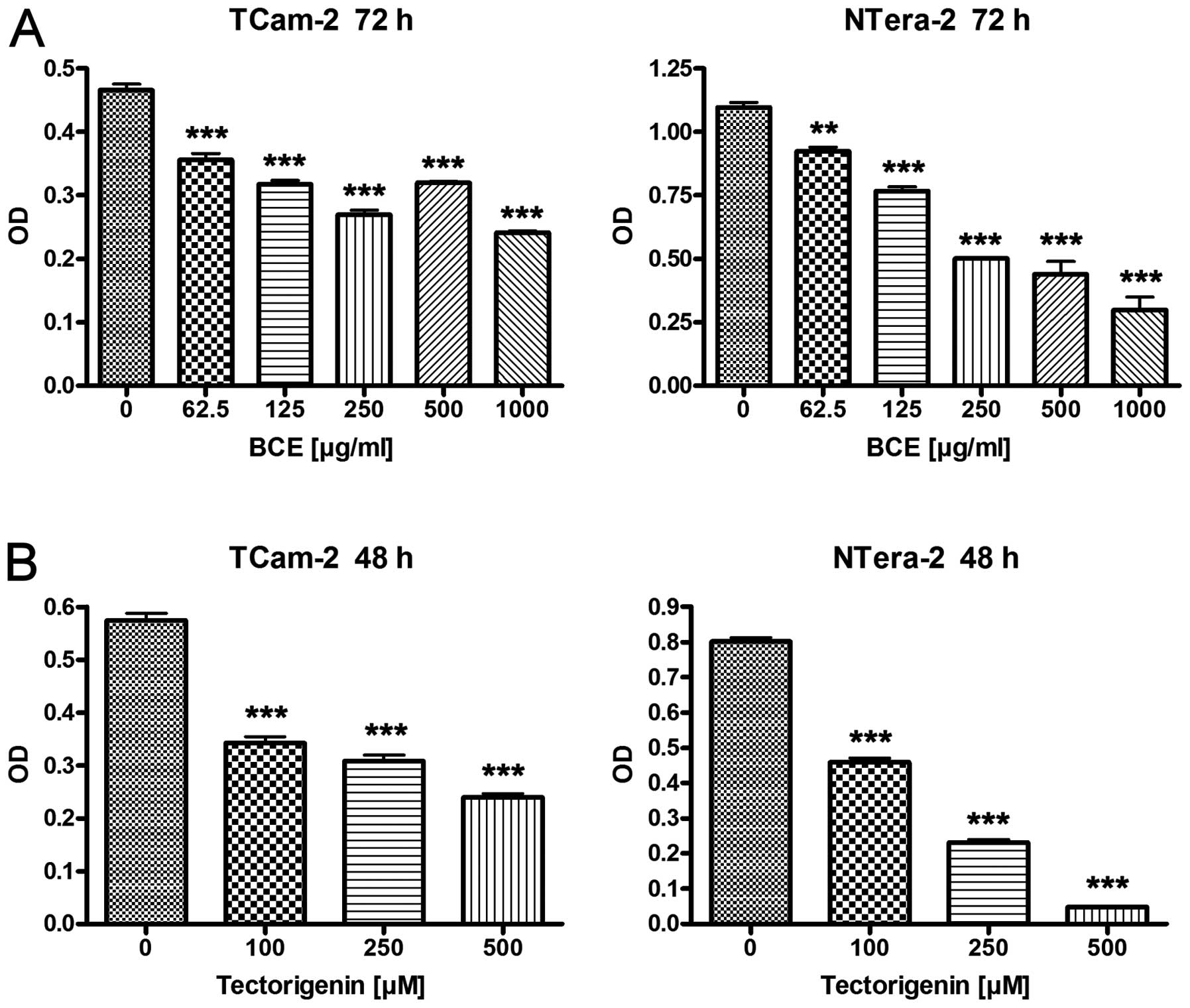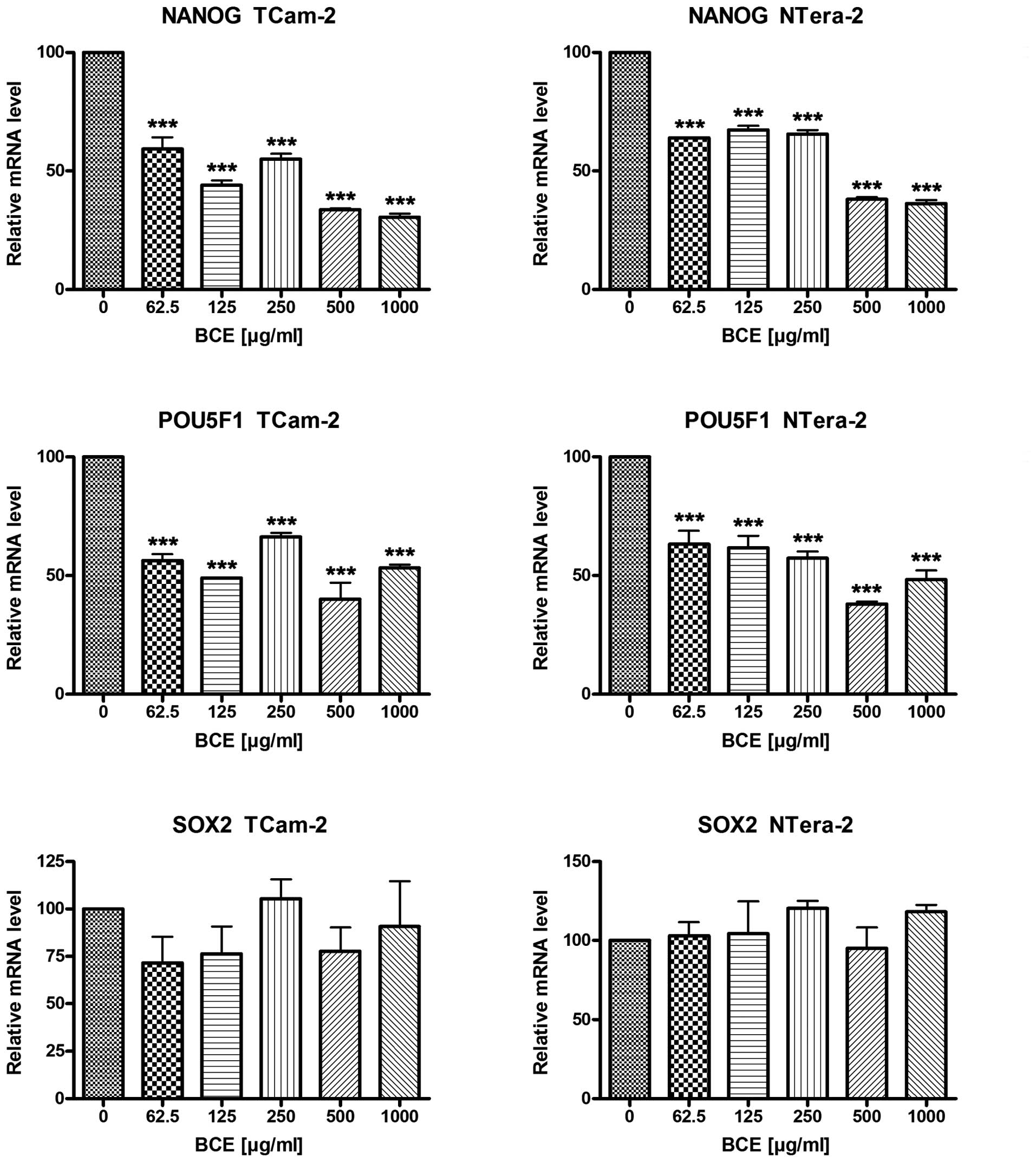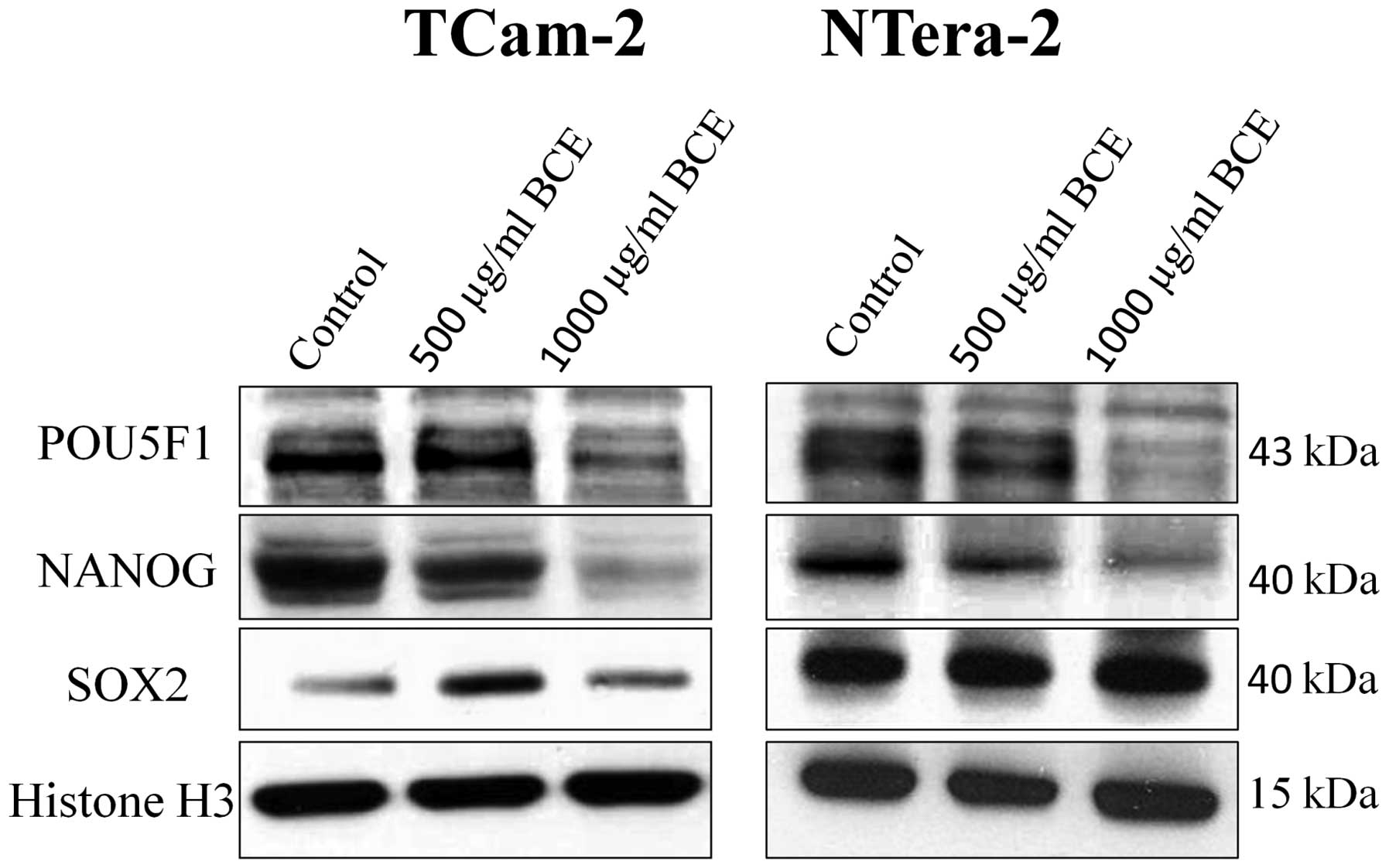|
1.
|
Hayes-Lattin B and Nichols CR: Testicular
cancer: a prototypic tumor of young adults. Semin Oncol.
36:432–438. 2009. View Article : Google Scholar : PubMed/NCBI
|
|
2.
|
Mannuel HD and Hussain A: Update on
testicular germ cell tumors. Curr Opin Oncol. 22:236–241. 2010.
View Article : Google Scholar : PubMed/NCBI
|
|
3.
|
Rajpert-De Meyts E: Developmental model
for the pathogenesis of testicular carcinoma in situ: genetic and
environmental aspects. Hum Reprod Update. 12:303–323.
2006.PubMed/NCBI
|
|
4.
|
Looijenga LHJ: Human testicular
(non)seminomatous germ cell tumours: the clinical implications of
recent pathobiological insights. J Pathol. 218:146–162. 2009.
View Article : Google Scholar : PubMed/NCBI
|
|
5.
|
Nichols J, Zevnik B, Anastassiadis K, Niwa
H, Klewe-Nebenius D, Chambers I, Schöler H and Smith A: Formation
of pluripotent stem cells in the mammalian embryo depends on the
POU transcription factor Oct4. Cell. 95:379–391. 1998. View Article : Google Scholar : PubMed/NCBI
|
|
6.
|
Kehler J, Tolkunova E, Koschorz B, Pesce
M, Gentile L, Boiani M, Lomelí H, Nagy A, McLaughlin KJ, Schöler HR
and Tomilin A: Oct4 is required for primordial germ cell survival.
EMBO Rep. 5:1078–1083. 2004. View Article : Google Scholar : PubMed/NCBI
|
|
7.
|
Abate-Shen C: Homeobox genes and cancer:
new OCTaves for an old tune. Cancer Cell. 4:329–330. 2003.
View Article : Google Scholar : PubMed/NCBI
|
|
8.
|
Liu N, Lu M, Tian X and Han Z: Molecular
mechanisms involved in self-renewal and pluripotency of embryonic
stem cells. J Cell Physiol. 211:279–286. 2007. View Article : Google Scholar : PubMed/NCBI
|
|
9.
|
Jeter CR, Badeaux M, Choy G, Chandra D,
Patrawala L, Liu C, Calhoun-Davis T, Zaehres H, Daley GQ and Tang
DG: Functional evidence that the self-renewal gene NANOG regulates
human tumor development. Stem Cells. 27:993–1005. 2009. View Article : Google Scholar : PubMed/NCBI
|
|
10.
|
You JS, Kang JK, Seo D-W, Park JH, Park
JW, Lee JC, Jeon YJ, Cho EJ and Han JW: Depletion of embryonic stem
cell signature by histone deacetylase inhibitor in NCCIT cells:
involvement of Nanog suppression. Cancer Res. 69:5716–5725. 2009.
View Article : Google Scholar : PubMed/NCBI
|
|
11.
|
Adlercreutz H: Phytoestrogens:
epidemiology and a possible role in cancer protection. Environ
Health Perspect. 103:103–112. 1995. View Article : Google Scholar : PubMed/NCBI
|
|
12.
|
Glazier MG and Bowman MA: A review of the
evidence for the use of phytoestrogens as a replacement for
traditional estrogen replacement therapy. Arch Intern Med.
161:1161–1172. 2001. View Article : Google Scholar : PubMed/NCBI
|
|
13.
|
Wagner H, Bauer R, Xiao P, Chen J and
Nenninger A: Rhizoma belamcandae sinensis (Shegan). Chinese Drug
Monographs and Analysis. 2:Verlag fur Ganzheitliche Medizin Dr.
Erich Wuhr, Kotzing. 1–13. 1999.
|
|
14.
|
Lee KT, Sohn IC, Kim YK, Choi JH, Choi JW,
Park HJ, Itoh Y and Mikayamoto K: Tectorigenin, an isoflavone of
Pueraria thunbergiana Benth, induces differentiation and
apoptosis in human promyelocytic leukemia HL-60 cells. Biol Pharm
Bull. 24:1117–1121. 2001.PubMed/NCBI
|
|
15.
|
Thelen P, Scharf J-G, Burfeind P,
Hemmerlein B, Wuttke W, Spengler B, Christoffel V, Ringert R-H and
Seidlova-Wuttke D: Tectorigenin and other phytochemicals extracted
from leopard lily Belamcanda chinensis affect new and
established targets for therapies in prostate cancer.
Carcinogenesis. 26:1360–1367. 2005. View Article : Google Scholar : PubMed/NCBI
|
|
16.
|
Thelen P, Peter T, Hünermund A, Kaulfuss
S, Seidlová-Wuttke D, Wuttke W, Ringert R-H and Seseke F:
Phytoestrogens from Belamcanda chinensis regulate the
expression of steroid receptors and related cofactors in LNCaP
prostate cancer cells. BJU Int. 100:199–203. 2007.PubMed/NCBI
|
|
17.
|
Venkataramani V, Rossner C, Iffland L,
Schweyer S, Tamboli IY, Walter J, Wirths O and Bayer TA: Histone
deacetylase inhibitor valproic acid inhibits cancer cell
proliferation via down-regulation of the alzheimer amyloid
precursor protein. J Biol Chem. 285:10678–10689. 2010. View Article : Google Scholar : PubMed/NCBI
|
|
18.
|
Smyth GK: Linear models and empirical
Bayes methods for assessing differential expression in microarray
experiments. Stat Appl Genet Mol Biol. 3:Article 3. 2004.PubMed/NCBI
|
|
19.
|
Gentleman RC, Carey VJ, Bates DM, Bolstad
B, Dettling M, Dudoit S, Ellis B, Gautier L, Ge Y, Gentry J, Hornik
K, Hothorn T, Huber W, Iacus S, Irizarry R, Leisch F, Li C,
Maechler M, Rossini AJ, Sawitzki G, Smith C, Smyth G, Tierney L,
Yang JYH and Zhang J: Bioconductor: open software development for
computational biology and bioinformatics. Genome Biol. 5:R802004.
View Article : Google Scholar : PubMed/NCBI
|
|
20.
|
Ben-Porath I, Thomson MW, Carey VJ, Ge R,
Bell GW, Regev A and Weinberg RA: An embryonic stem cell-like gene
expression signature in poorly differentiated aggressive human
tumors. Nat Genet. 40:499–507. 2008. View
Article : Google Scholar : PubMed/NCBI
|
|
21.
|
Lamb J, Crawford ED, Peck D, Modell JW,
Blat IC, Wrobel MJ, Lerner J, Brunet J-P, Subramanian A, Ross KN,
Reich M, Hieronymus H, Wei G, Armstrong SA, Haggarty SJ, Clemons
PA, Wei R, Carr SA, Lander ES and Golub TR: The connectivity map:
using gene-expression signatures to connect small molecules, genes,
and disease. Science. 313:1929–1935. 2006. View Article : Google Scholar
|
|
22.
|
Morrissey C, Bektic J, Spengler B, Galvin
D, Christoffel V, Klocker H, Fitzpatrick JM and Watson WG:
Phytoestrogens derived from Belamcanda chinensis have an
antiproliferative effect on prostate cancer cells in vitro. J Urol.
172:2426–2433. 2004.
|
|
23.
|
Yamaki M, Kato T, Kashihara M and Takagi
S: Isoflavones of Belamcanda chinensis. Planta Med.
56:3351990.
|
|
24.
|
Ito H, Onoue S and Yoshida T:
Isoflavonoids from Belamcanda chinensis. Chem Pharm Bull
(Tokyo). 49:1229–1231. 2001. View Article : Google Scholar : PubMed/NCBI
|
|
25.
|
Zhang YY, Wang Q, Qi LW, Qin XY and Qin
MJ: Characterization and determination of the major constituents in
Belamcandae Rhizoma by HPLC-DAD-ESI-MS(n). J Pharm Biomed
Anal. 56:304–314. 2011. View Article : Google Scholar : PubMed/NCBI
|
|
26.
|
De Jong J, Stoop H, Gillis AJM, Hersmus R,
van Gurp RJ, van de Geijn GJM, van Drunen E, Beverloo HB, Schneider
DT, Sherlock JK, Baeten J, Kitazawa S, van Zoelen EJ, van
Roozendaal K, Oosterhuis W and Looijenga LHJ: Further
characterization of the first seminoma cell line TCam-2. Genes
Chromosomes Cancer. 47:185–196. 2008.PubMed/NCBI
|
|
27.
|
Greber B, Lehrach H and Adjaye J:
Silencing of core transcription factors in human EC cells
highlights the importance of autocrine FGF signaling for
self-renewal. BMC Dev Biol. 7:462007. View Article : Google Scholar : PubMed/NCBI
|
|
28.
|
Van den Berg DLC, Zhang W, Yates A,
Engelen E, Takacs K, Bezstarosti K, Demmers J, Chambers I and Poot
RA: Estrogen-related receptor beta interacts with Oct4 to
positively regulate Nanog gene expression. Mol Cell Biol.
28:5986–5995. 2008.PubMed/NCBI
|
|
29.
|
Regenbrecht CR, Jung M, Lehrach H and
Adjaye J: The molecular basis of genistein-induced mitotic arrest
and exit of self-renewal in embryonal carcinoma and primary cancer
cell lines. BMC Med Genomics. 1:492008. View Article : Google Scholar : PubMed/NCBI
|
|
30.
|
Ezeh UI, Turek PJ, Reijo RA and Clark AT:
Human embryonic stem cell genes OCT4, NANOG, STELLAR, and GDF3 are
expressed in both seminoma and breast carcinoma. Cancer.
104:2255–2265. 2005. View Article : Google Scholar : PubMed/NCBI
|
|
31.
|
Dong Y-L, Reddy DM, Green KE, Chauhan MS,
Wang HQ, Nagamani M, Hankins GDV and Yallampalli C: Calcitonin
gene-related peptide (CALCA) is a proangiogenic growth factor in
the human placental development. Biol Reprod. 76:892–899. 2007.
View Article : Google Scholar : PubMed/NCBI
|
|
32.
|
Chim SM, Qin A, Tickner J, Pavlos N, Davey
T, Wang H, Guo Y, Zheng MH and Xu J: EGFL6 promotes endothelial
cell migration and angiogenesis through the activation of
extracellular signal-regulated kinase. J Biol Chem.
286:22035–22046. 2011. View Article : Google Scholar : PubMed/NCBI
|
|
33.
|
Das S, Harris LG, Metge BJ, Liu S, Riker
AI, Samant RS and Shevde LA: The hedgehog pathway transcription
factor GLI1 promotes malignant behavior of cancer cells by
up-regulating osteopontin. J Biol Chem. 284:22888–22897. 2009.
View Article : Google Scholar : PubMed/NCBI
|
|
34.
|
Stange DE, Engel F, Longerich T, Koo BK,
Koch M, Delhomme N, Aigner M, Toedt G, Schirmacher P, Lichter P,
Weitz J and Radlwimmer B: Expression of an ASCL2 related stem cell
signature and IGF2 in colorectal cancer liver metastases with
11p15.5 gain. Gut. 59:1236–1244. 2010. View Article : Google Scholar : PubMed/NCBI
|
|
35.
|
Riley P, Anson-Cartwright L and Cross JC:
The Hand1 bHLH transcription factor is essential for placentation
and cardiac morphogenesis. Nat Genet. 18:271–275. 1998. View Article : Google Scholar : PubMed/NCBI
|
|
36.
|
Jung M, Peterson H, Chavez L, Kahlem P,
Lehrach H, Vilo J and Adjaye J: A data integration approach to
mapping OCT4 gene regulatory networks operative in embryonic stem
cells and embryonal carcinoma cells. PLoS One. 5:e107092010.
View Article : Google Scholar : PubMed/NCBI
|
|
37.
|
Wang W, Chan EK, Baron S, Van de Water T
and Lufkin T: Hmx2 homeobox gene control of murine vestibular
morphogenesis. Development. 128:5017–5029. 2001.PubMed/NCBI
|
|
38.
|
Jin B, Yao B, Li J-L, Fields CR, Delmas
AL, Liu C and Robertson KD: DNMT1 and DNMT3B modulate distinct
polycomb-mediated histone modifications in colon cancer. Cancer
Res. 69:7412–7421. 2009. View Article : Google Scholar
|
|
39.
|
Carpten JD, Faber AL, Horn C, Donoho GP,
Briggs SL, Robbins CM, Hostetter G, Boguslawski S, Moses TY, Savage
S, Uhlik M, Lin A, Du J, Qian Y-W, Zeckner DJ, Tucker-Kellogg G,
Touchman J, Patel K, Mousses S, Bittner M, Schevitz R, Lai MHT,
Blanchard KL and Thomas JE: A transforming mutation in the
pleckstrin homology domain of AKT1 in cancer. Nature. 448:439–444.
2007. View Article : Google Scholar : PubMed/NCBI
|
|
40.
|
Nakayama T, Hirakawa H, Shibata K, Nazneen
A, Abe K, Nagayasu T and Taguchi T: Expression of angiopoietin-like
4 (ANGPTL4) in human colorectal cancer: ANGPTL4 promotes venous
invasion and distant metastasis. Oncol Rep. 25:929–935. 2011.
View Article : Google Scholar : PubMed/NCBI
|
|
41.
|
Kelly LM, Englmeier U, Lafon I, Sieweke MH
and Graf T: MafB is an inducer of monocytic differentiation. EMBO
J. 19:1987–1997. 2000. View Article : Google Scholar
|
|
42.
|
Barillé-Nion S, Barlogie B, Bataille R,
Bergsagel PL, Epstein J, Fenton RG, Jacobson J, Kuehl WM,
Shaughnessy J and Tricot G: Advances in biology and therapy of
multiple myeloma. Hematology Am Soc Hematol Educ Program. 248–278.
2003.PubMed/NCBI
|
|
43.
|
Pouponnot C, Sii-Felice K, Hmitou I,
Rocques N, Lecoin L, Druillennec S, Felder-Schmittbuhl M-P and
Eychène A: Cell context reveals a dual role for Maf in oncogenesis.
Oncogene. 25:1299–1310. 2006. View Article : Google Scholar : PubMed/NCBI
|
|
44.
|
Zhang YQ, Mashima H and Kojima I: Changes
in the expression of transcription factors in pancreatic AR42J
cells during differentiation into insulin-producing cells.
Diabetes. 50:S10–S14. 2001. View Article : Google Scholar
|
|
45.
|
Gasa R, Mrejen C, Lynn FC, Skewes-Cox P,
Sanchez L, Yang KY, Lin CH, Gomis R and German MS: Induction of
pancreatic islet cell differentiation by the neurogenin-neuroD
cascade. Differ Res Biol Divers. 76:381–391. 2008. View Article : Google Scholar : PubMed/NCBI
|
|
46.
|
Zenmyo M, Tanimoto A, Sakakima H, Yokouchi
M, Nagano S, Yamamoto T, Ishido Y, Komiya S and Ijiri K: Gadd45β
expression in chondrosarcoma: a pilot study for diagnostic and
biological implications in histological grading. Diagn Pathol.
5:692010.
|
|
47.
|
Kikuno N, Shiina H, Urakami S, Kawamoto K,
Hirata H, Tanaka Y, Majid S, Igawa M and Dahiya R: Genistein
mediated histone acetylation and demethylation activates tumor
suppressor genes in prostate cancer cells. Int J Cancer.
123:552–560. 2008. View Article : Google Scholar : PubMed/NCBI
|
|
48.
|
Majid S, Dar AA, Shahryari V, Hirata H,
Ahmad A, Saini S, Tanaka Y, Dahiya AV and Dahiya R: Genistein
reverses hypermethylation and induces active histone modifications
in tumor suppressor gene B-cell translocation gene 3 in prostate
cancer. Cancer. 116:66–76. 2010.PubMed/NCBI
|
|
49.
|
Bolden JE, Peart MJ and Johnstone RW:
Anticancer activities of histone deacetylase inhibitors. Nat Rev
Drug Discov. 5:769–784. 2006. View Article : Google Scholar : PubMed/NCBI
|
|
50.
|
Iván G, Szigeti-Csúcs N, Oláh M, Nagy GM
and Góth MI: Treatment of pituitary tumors: dopamine agonists.
Endocrine. 28:101–110. 2005.PubMed/NCBI
|
|
51.
|
Ferrari C and Crosignani PG: Medical
treatment of hyperprolactinaemic disorders. Hum Reprod. 1:507–514.
1986.
|
|
52.
|
Omisanjo OA, Biermann K, Hartmann S,
Heukamp LC, Sonnack V, Hild A, Brehm R, Bergmann M, Weidner W and
Stege K: DNMT1 and HDAC1 gene expression in impaired
spermatogenesis and testicular cancer. Histochem Cell Biol.
127:175–181. 2007. View Article : Google Scholar : PubMed/NCBI
|














